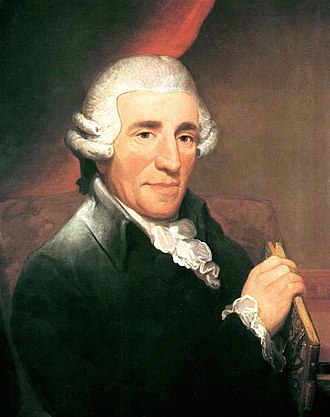The Symphony No. 82 in C major, Hoboken 1/82, is the first of the six Paris Symphonies written by Joseph Haydn. It is popularly known as the Bear Symphony.

Symphony No. 43 in E♭ major, Hoboken I/43, is a symphony by Joseph Haydn. Since the nineteenth century it has been referred to by the subtitle "Mercury". The source of the "Mercury" nickname remains unknown according to Matthew Rye. It could refer to its use as incidental music from some play or other given at Eszterháza, or it may not have appeared until the nineteenth century. It would certainly be wrong to impose any programmatic elements on to the abstract musical drama and search for a portrait of the gods’ winged messenger.

Symphony No. 35 in B♭ major, Hoboken I/35, was written by Joseph Haydn. The autograph score is "carefully" dated "December 10, 1767". It has been speculated that this symphony was written to celebrate Prince Esterházy's return from a visit to the Palace of Versailles.

The Symphony No. 32 in C major is a festive symphony by Joseph Haydn. The exact date of composition is unknown. It has been suggested by noted Haydn scholar H.C. Robbins Landon that it could have been written as early as 1757 and as late as 1763. More recent scholars have suggested it was composed in either 1760 or 1761

The Symphony No. 33 in C major is a festive symphony by Joseph Haydn. The precise date of composition is unknown. Haydn scholar H.C. Robbins Landon has dated this work to 1763–65. It has also been suggested that it was written in 1760 or 1761, along with Symphony no. 32.

Joseph Haydn wrote Symphony No. 24 in D major, Hoboken I/24, in 1764.

Joseph Haydn wrote Symphony No. 23 in G major, Hoboken I/23, in 1764.

The Symphony No. 25 in C major, Hoboken I/25, is a symphony by Joseph Haydn.The symphony was most likely composed in 1763, or at the very earliest in 1761, at about the same time as No. 33.

Joseph Haydn's Symphony No. 27 in G major was probably written before March 19, 1761, while he was employed by Count Morzin. Its chronological position was assigned by Eusebius Mandyczewski in 1907. Although later adopted by Hoboken, Robbins Landon has subsequently revised the work's likely chronological position and now believes that the symphony is one of Haydn's earliest, written at roughly the same time as symphonies nos. 15–18. Haydn himself may have labeled the symphony his 16th, although this remains unclear.

Joseph Haydn's Symphony No. 1 in D major, Hoboken I/1, was written in 1759 in Dolní Lukavice, while in the service of Count Morzin. Though identified by Haydn as his first symphony, scholars are not sure if it is actually the first he composed, or even the first that survived to posterity. While it is reliably known that No. 1 was written in 1759, H. C. Robbins Landon cannot rule out that No. 2,No. 4, or both could have been composed in 1757 or 1758.

Joseph Haydn's Symphony No. 2 in C major, Hoboken I/2, is believed to have been written between 1757 and 1761.

Joseph Haydn's Symphony No. 3 in G major, Hoboken I/3, is believed to have been written between 1760 and 1762.

Joseph Haydn's Symphony No. 4 in D major, Hoboken I/4, is believed to have been written between 1757 and 1761.

Joseph Haydn's Symphony No. 14 in A major, Hoboken I/14, may have been written between 1761 and 1763.

Joseph Haydn's Symphony No. 15 in D major, Hoboken I/15, may have been written between 1760 and 1763.

Joseph Haydn's Symphony No. 17 in F major, Hoboken I/17, may have been written between 1757 and 1763.

The Symphony No. 9 in C major, Hoboken I/9, is a symphony by Joseph Haydn. The symphony was composed in 1762, under the auspices of Nikolaus Esterházy, who allowed the symphony to be performed in Eisenstadt.

The Symphony No. 10 in D major, Hoboken I/10, is a symphony by Joseph Haydn. The symphony may have been written as early as 1757 but no later than 1761, probably for the small, but resourceful orchestra of Count Morzin.

Joseph Haydn's Symphony No. 11 in E♭ major is a symphony which may have been written as early as 1760 but no later than 1762, meaning that it was written for either the orchestra of the salubrious Count Morzin or the noble Paul II Anton, Prince Esterházy's palace in Eisenstadt.

The Symphony No. 18 in G major, Hoboken I/18, is a symphony by Joseph Haydn. The composition date is conspicuously uncertain. The Breitkopf catalogue entry assures that it was composed no later than March 1766, the date of the Esterhazy orchestra moving to Esterhaza, but most scholars believe it was composed at least a few years before then. Dates between 1757 and 1764 have been also suggested but not proven.


